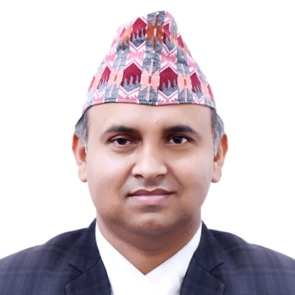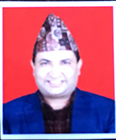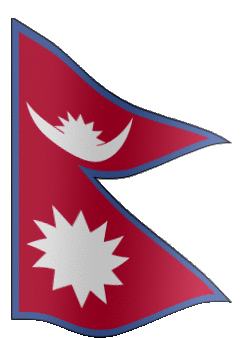Introduction
Topography
Nepal is a landlocked country with a total area of 147.516 sq km. It lies between 26º 22’ N - 30º 27’ N latitudes and 80º 4’E-88º 12'E longitudes. Roughly rectangular in shape, the land extends approximately 885 km, east west and 145 km. at its narrowest to 241 km. at Us broadest, north south. The country is bordered by China in the north and by India in the south, west and east. The land mass is divided into three geographical zones, the snow capped high Himalayas, the mountainous region with long terraced slopes leading to fertile valleys and the flat sub-tropical Terai region. The high Himalayan region extends in the north from west to east at an altitude of 4,000 m. to 8848 m. The world famous peaks of Mt. Everest (8848 m.), Kanchanjanga (8586 m), Makalu(8463 m.), Dhaulagiri (8167 m.), Annapurna (8091 m.), and many others dominate the formidable range of eternal snows. The middle mountainous region consists of mountain ranges of mahabharat varying in height from 1525 m. to 4877 m. below 610 m. to 1524 m. fertile valleys of various widths and altitudes lie between these mountain and hill ranges. The southern belt stretches east west with a width of 26 to 32 km. and a maximum elevation of about 305 m. Several major rivers, tributaries and streams flow south originating from the glaciers, snow fed lakes and high Himalayan Mountains of the north. The major rivers are Mahakali, Seti, Karnali, Gandaki, Koshi and Mechi.
Climate
Nepal experiences 4 seasons spring (Mar-May), summer (Jun.- Aug.), autumn (Sept.-Nov.) and winter (Dec.-Feb). The climate is varied ranging from the sub-tropical Terai to the cool dry temperate and alpine climate in the northern Himalayan ranges. In the Terai, the hottest part of the country, summer temperatures may rise as high as 40 c The climate is hot and humid. In the mid-mountain region, the summer climate is mild with temperatures around 25°-27°c. The winter temperatures range from 7"c to 23°c in the terai and sub-zero to 12°c in the mountain regions and valleys. The northern Himalayan region has an alpine climate. The valley of Kathmandu has a pleasant equable climate with average summer and winter temperatures of 19°-27°c and 2°-12°c respectively. The average temperature and rainfall records in Kathmandu arc listed below: Rainfall is widespread during the south-west monsoon period from June to August with the eastern part receiving maximum rainfall.
| Month | Min | Max | Rain Fall |
| (c) | (C) | (mm) | |
| January | 2.7 | 17.5 | 47 |
| February | 2.2 | 21.6 | 11 |
| March | 6.9 | 25.5 | 15 |
| April | 8.6 | 30.0 | 5 |
| May | 15.6 | 29.7 | 146 |
| June | 18.9 | 29.4 | 135 |
| July | 19.5 | 28.1 | 327 |
| August | 19.2 | 29.5 | 206 |
| September | 18.6 | 28.6 | 199 |
| October | 13.3 | 28.6 | 42 |
| November | 6.0 | 23.7 | 0 |
| December | 1.9 | 20.7 | 1 |
In the winter season, the westernpart receives a larger share of rainfall. The period from October to May is generally dry in most parts of the country Annual precipitation varies from around 300 min in the northern and western areas to over 2500 mm. in the eastern region. Kathmandu Valley receives around 1200 mm. of annual rainfall with a heavy concentration from June to August.
Political System
The major feature of the new constitution is the adoption of a parliamentary system of government based on multi-party democracy with a constitutional monarchy. The concept of the rule of law is enshrined within an independent judicial system. The Constitution also guarantees the safeguard of the basic human rights, freedoms and equality.
The constitution affirms that Nepal is a multi-ethnic, multi-lingual, democratic, independent, indivisible, sovereign, Hindu and constitutional monarchical kingdom.The constitution provides for a bicameral parliamentary system of government with two houses, the House of Representatives, where members are elected directly from adult franchise and the National Council, an upper house with elected seniors and nominees. The leader of the parliamentary board of the party which commands a majority in the House of Representatives is appointed Prime Minister.
Social and Cultural Environment
The unique feature of the Nepalese society is its ethnic, linguistic, religious and cultural diversity from ancient times, migrant tribes from the east, the north and the south entered the land, met the natives and settled there. They are the Nepalese people. The Brahmins, Kshetriyas, Thakuris, Tharus, Yadavs, Dhimals, Newars, Gurungs, Magars, Limbus, Rais, Sherpas, Tamangs and others all all ethnically members of the Indo Aryan and Tibeto-Burinan families.
The people are religious and the practice of religious worship is a part of everyday life. Hinduism is the state religion of Nepal. As many as 81.3 percent of the total population are Hindus. 9 percent are Buddhists, 4.4 percent are Muslims and 5.3 percent are Jains, Christians and others. There is a unique blend of Hinduism and Buddhism. The two religions have overlapped and harmonized to the extent that Hindus and Buddhists worship the same gods.
Nepali is the lingua franca of the country and is written in Devanagari script. Other languages are Maithili, Bhojpuri, Newari, Gurung, Tamang, Tharu. Magar, Limbu, Rai, Kirati, Bhote and so on. English is, spoken and understood by people in most urban centres.
Nepal has maintained one of the world's oldest and richest continuous cultures. Her culture finds exquisite expression in the fields of religion, art, music, dance, social and socio-religious festivals. There are literally thousands of temples, shrines, pagodas, intricate woodcarvings and bronze and stone images of great beauty
Festivals are a prominent aspect of Nepalese life, in which all people participate enthusiastically. Dashain (DurgaPuja). Tihar (festival of lights). Shiva Ratri (in honour of lord Shiva). Indra Jatra (festival of Indra, the rain god), Baishakh Purnima (to pay homage to lord Buddha), Gai Jatra (cow festival) and a host of other festivals are celebrated throughout the year.
International Relations
Nepal's foreign policy objectives are guided by the principles enshrined in the Charter of the United Nations and the Nonalignment. As such, Nepal enjoys cordial relations with all the countries of the world. This is also manifested by the expansion of the diplomatic relations, which has reached to 113 countries in 2003 Through 18 residential embassies, 3 consulates, and numerous honorary consul generals/consuls abroad; Nepal is striving to consolidate bilateral and multilateral relations with the friendly countries and international organizations. Meanwhile, 21 embassies, consulates, cooperation offices, country representatives of various international organizations including the UN, World Bank, IMF and ADB based in Kathmandu have equally made significant contributions to help achieve these goals.
Nepal attaches considerable importance to the promotion of closer economic cooperation in South Asia. To this end. Nepal is actively working with other members of SAARC for the creation of the South Asian Free Trade Area (SAFTA) and is also engaged in the sub regional cooperation in the form of South Asian Growth Quadrangle (SAGQ). Nepal is the host of the SAARC Secretariat.
Economic diplomacy has acquired yet another significant dimension of Nepal's foreign policy priorities in recent years. Its main objectives are to promote Nepal's export trade, attract greater number of tourists to Nepal, and to enhance the flow of foreign direct investment in the economy.
*Source : Nepal Foreign Investment Opportunities, MOIC

Damodar Bhandari
Honorable Minister

Krishna Bahadur Raut
Secretary


